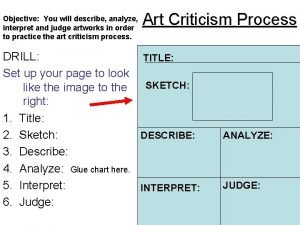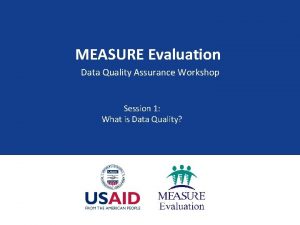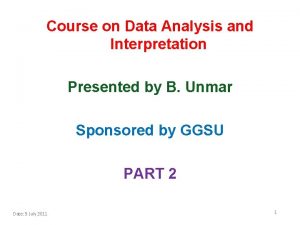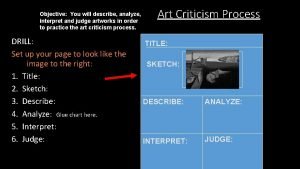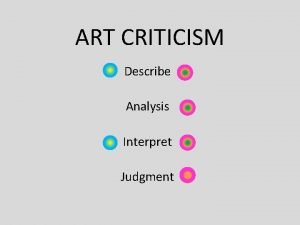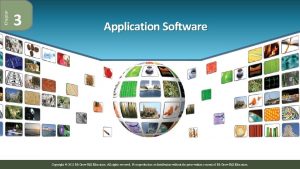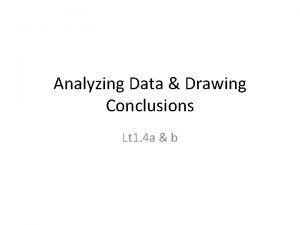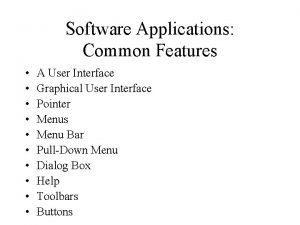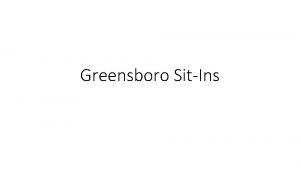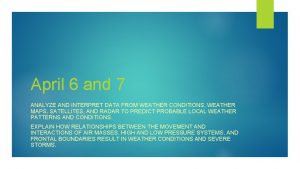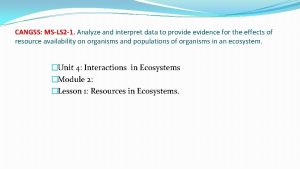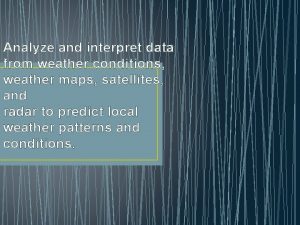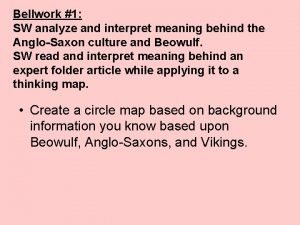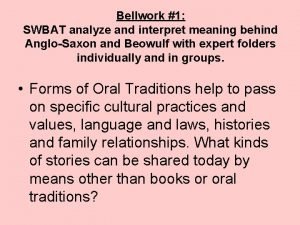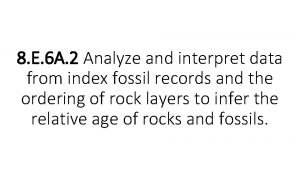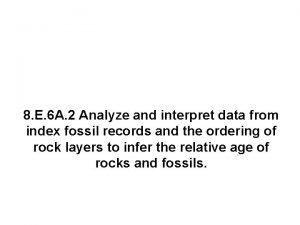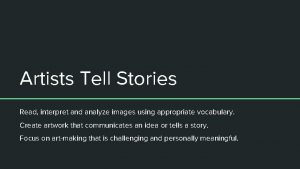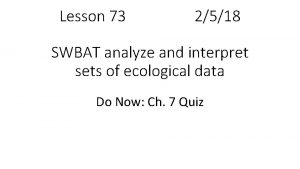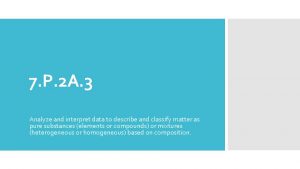SO THAT WE CAN INTERPRET AND ANALYZE DATA



















- Slides: 19

SO THAT WE CAN: INTERPRET AND ANALYZE DATA FROM THE FOSSIL RECORD TO SUPPORT A CLAIM THAT ORGANISMS AND ENVIRONMENTS HAVE EVOLVED OVER TIME YOU WILL KNOW YOU HAVE IT WHEN: YOU CAN IDENTIFY INDEX FOSSIL AND TIME PERIOD Warm up: Write down what you think an index fossil is based off of this picture:

The Law of Superposition, which states that in an undisturbed horizontal sequence of rocks, the oldest rock layers will be on the bottom, with successively younger rocks on top of these, helps geologists correlate rock layers around the world. This also means that fossils found in the lowest levels in a sequence of layered rocks represent the oldest record of life there. By matching partial sequences, the truly oldest layers with fossils can be worked out.

What is relative age? Think-pair-share BY CORRELATING FOSSILS FROM VARIOUS PARTS OF THE WORLD, SCIENTISTS ARE ABLE TO GIVE RELATIVE AGES TO PARTICULAR STRATA. RELATIVE DATING TELLS SCIENTISTS IF A ROCK LAYER IS "OLDER" OR "YOUNGER" THAN ANOTHER.

Geological time scale THIS RELATIVE TIME SCALE DIVIDES THE VAST AMOUNT OF EARTH HISTORY INTO VARIOUS SECTIONS BASED ON GEOLOGICAL EVENTS (SEA ENCROACHMENTS, MOUNTAIN-BUILDING, AND DEPOSITIONAL EVENTS), AND NOTABLE BIOLOGICAL EVENTS (APPEARANCE, RELATIVE ABUNDANCE, OR EXTINCTION OF CERTAIN LIFE FORMS).

How is a geological time scale made WITH YOUR GROUP DISCUSS WHAT ARE THE MAJOR COMPONENTS OF THE TIME SCALE.




How are the layers of the earth helpful in interpreting earth’s history?

COMPARE AND CONTRAST WITH A PARTNER EACH LAYER AND ITS IMPORTANCE.

WHAT CAN YOU INTERPRET ABOUT THIS PICTURE?


1) Spread the cards with the nonsense syllables on the table and determine the correct sequence of the eight cards by comparing letters that are common to individual cards and, therefore, overlap. The first card in the sequence has "Card 1, Set A" in the lower left-hand corner and represents the bottom of the sequence. If the letters "T" and "C" represent fossils in the oldest rock layer, they are the oldest fossils, or the first fossils formed in the past for this sequence of rock layers. 2. Now, look for a card that has either a "T" or "C" written on it. Since this card has a common letter with the first card, it must go on top of the "TC" card. The fossils represented by the letters on this card are "younger" than the "T" or "C" fossils on the "TC" card which represents fossils in the oldest rock layer. Sequence the remaining cards by using the same process. When you finish, you should have a vertical stack of cards with the top card representing the youngest fossils of this rock sequence and the "TC" card at the bottom of the stack representing the oldest fossils

1) After you have arranged the cards in order, write your sequence of letters (using each letter only once) on a separate piece of paper. Starting with the top card, the letters should be in order from youngest to oldest. 2) How do you know that "X" is older than "M"? 3) Explain why "D" in the rock layer represented by DM is the same age as "M. " 4) Explain why "D" in the rock layer represented by OXD is older than "D" in the rock layer represented by DM. EXIT TICKET: QUESTIONS YOU ANSWER WITH A PARTNER THEN SHARE WITH NEW GROUP


1) Carefully examine the second set of cards which have sketches of fossils on them. Each card represents a particular rock layer with a collection of fossils that are found in that particular rock stratum. All of the fossils represented would be found in sedimentary rocks of marine origin. Figure 2 -A gives some background information on the individual fossils. 2) The oldest rock layer is marked with the letter "M" in the lower left-hand corner. The letters on the other cards have no significance to the sequencing procedure and should be ignored at this time. Find a rock layer that has at least one of the fossils you found in the oldest rock layer. This rock layer would be younger as indicated by the appearance of new fossils in the rock stratum. Keep in mind that extinction is forever. Once an organism disappears from the sequence it cannot reappear later. Use this information to sequence the cards in a vertical stack of fossils in rock strata. Arrange them from oldest to youngest with the oldest layer on the bottom and the youngest on top.

1) Using the letters printed in the lower left-hand corner of each card, write the sequence of letters from the youngest layer to the oldest layer (i. e. , from the top of the vertical stack to the bottom). This will enable your teacher to quickly check whether you have the correct sequence. 2) Which fossil organisms could possibly be used as index fossils? 3) Name three organisms represented that probably could not be used as index fossils and explain why. 4) In what kinds of rocks might you find the fossils from this activity? 5) State the Law of Superposition and explain how this activity illustrates this law. QUESTIONS WITH PARTNER AND SHARE WITH NEW TABLE

Write two advantages and disadvantages about relative and absolute dating EXIT TICKET

Exam: CUCC and create a t chart Task q Analyzing q Write q Explaining q Discuss q Support Context q Work completed q Paragraph q Progress towards meeting goal q Strategies using or not using q Identifying changes you need to make
 Interpret and analyze
Interpret and analyze Describe the picture
Describe the picture Interpret and analyze
Interpret and analyze Example of analysis and interpretation of data
Example of analysis and interpretation of data Can you judge art objectively
Can you judge art objectively Description analysis interpretation judgement
Description analysis interpretation judgement Ngoại tâm thu thất chùm đôi
Ngoại tâm thu thất chùm đôi Block xoang nhĩ độ 2 type 1
Block xoang nhĩ độ 2 type 1 Thơ thất ngôn tứ tuyệt đường luật
Thơ thất ngôn tứ tuyệt đường luật Thơ thất ngôn tứ tuyệt đường luật
Thơ thất ngôn tứ tuyệt đường luật Walmart thất bại ở nhật
Walmart thất bại ở nhật Tìm vết của mặt phẳng
Tìm vết của mặt phẳng Hãy nói thật ít để làm được nhiều
Hãy nói thật ít để làm được nhiều Tôn thất thuyết là ai
Tôn thất thuyết là ai Gây tê cơ vuông thắt lưng
Gây tê cơ vuông thắt lưng Sau thất bại ở hồ điển triệt
Sau thất bại ở hồ điển triệt Mean absolute deviation vs standard deviation
Mean absolute deviation vs standard deviation Programs that organize analyze and graph numerical data
Programs that organize analyze and graph numerical data What conclusion can you draw out form the pie graph
What conclusion can you draw out form the pie graph Common features of application software
Common features of application software

